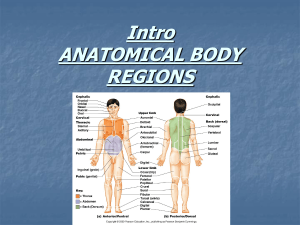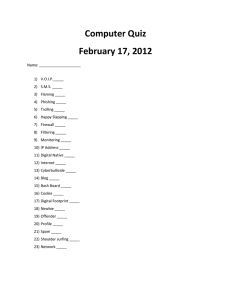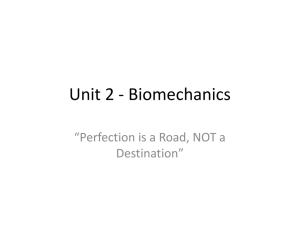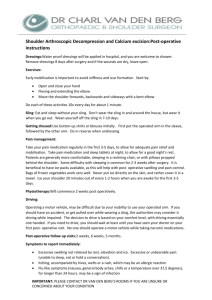Shoulder and elbow joint power differ as a general feature
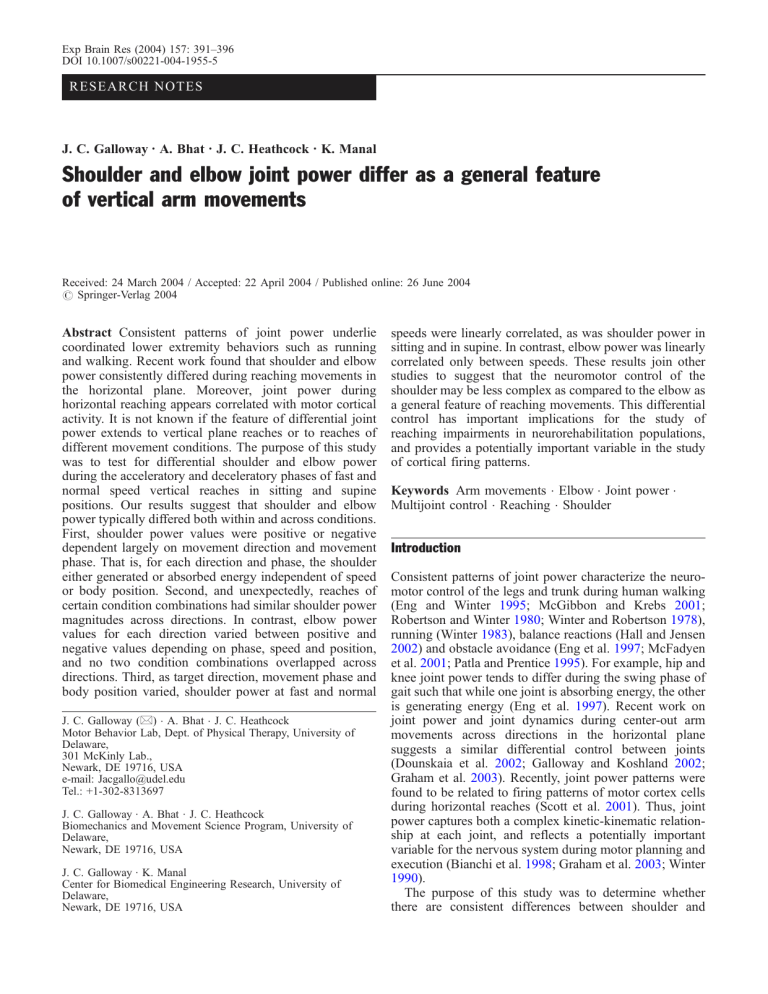
Exp Brain Res (2004) 157: 391
–
396
DOI 10.1007/s00221-004-1955-5
R E S E A R C H N O T E S
J. C. Galloway . A. Bhat . J. C. Heathcock . K. Manal
Shoulder and elbow joint power differ as a general feature of vertical arm movements
Received: 24 March 2004 / Accepted: 22 April 2004 / Published online: 26 June 2004
#
Springer-Verlag 2004
Abstract Consistent patterns of joint power underlie coordinated lower extremity behaviors such as running and walking. Recent work found that shoulder and elbow power consistently differed during reaching movements in the horizontal plane. Moreover, joint power during horizontal reaching appears correlated with motor cortical activity. It is not known if the feature of differential joint power extends to vertical plane reaches or to reaches of different movement conditions. The purpose of this study was to test for differential shoulder and elbow power during the acceleratory and deceleratory phases of fast and normal speed vertical reaches in sitting and supine positions. Our results suggest that shoulder and elbow power typically differed both within and across conditions.
First, shoulder power values were positive or negative dependent largely on movement direction and movement phase. That is, for each direction and phase, the shoulder either generated or absorbed energy independent of speed or body position. Second, and unexpectedly, reaches of certain condition combinations had similar shoulder power magnitudes across directions. In contrast, elbow power values for each direction varied between positive and negative values depending on phase, speed and position, and no two condition combinations overlapped across directions. Third, as target direction, movement phase and body position varied, shoulder power at fast and normal
J. C. Galloway (
* ) .
A. Bhat . J. C. Heathcock
Motor Behavior Lab, Dept. of Physical Therapy, University of
Delaware,
301 McKinly Lab.,
Newark, DE 19716, USA e-mail: Jacgallo@udel.edu
Tel.: +1-302-8313697
J. C. Galloway . A. Bhat . J. C. Heathcock
Biomechanics and Movement Science Program, University of
Delaware,
Newark, DE 19716, USA
J. C. Galloway . K. Manal
Center for Biomedical Engineering Research, University of
Delaware,
Newark, DE 19716, USA speeds were linearly correlated, as was shoulder power in sitting and in supine. In contrast, elbow power was linearly correlated only between speeds. These results join other studies to suggest that the neuromotor control of the shoulder may be less complex as compared to the elbow as a general feature of reaching movements. This differential control has important implications for the study of reaching impairments in neurorehabilitation populations, and provides a potentially important variable in the study of cortical firing patterns.
Keywords Arm movements . Elbow . Joint power .
Multijoint control . Reaching . Shoulder
Introduction
Consistent patterns of joint power characterize the neuromotor control of the legs and trunk during human walking
(Eng and Winter
; McGibbon and Krebs
;
Robertson and Winter
1980 ; Winter and Robertson 1978 ),
running (Winter
), balance reactions (Hall and Jensen
) and obstacle avoidance (Eng et al.
; McFadyen et al.
; Patla and Prentice
). For example, hip and knee joint power tends to differ during the swing phase of gait such that while one joint is absorbing energy, the other is generating energy (Eng et al.
joint power and joint dynamics during center-out arm movements across directions in the horizontal plane suggests a similar differential control between joints
(Dounskaia et al.
; Galloway and Koshland
;
Graham et al.
). Recently, joint power patterns were found to be related to firing patterns of motor cortex cells during horizontal reaches (Scott et al.
power captures both a complex kinetic-kinematic relationship at each joint, and reflects a potentially important variable for the nervous system during motor planning and execution (Bianchi et al.
; Graham et al.
).
The purpose of this study was to determine whether there are consistent differences between shoulder and
392 elbow joint power during the acceleratory and deceleratory phases of vertical plane reaching movements of different speeds and body positions. Reaching in the vertical plane presents a more complex kinetic-kinematic relationship than horizontal reaching due to the additional influence of gravitational torque (Fisk et al.
1998 ). We also chose to expand the test for shoulder-
elbow power differences to include the movement conditions of speed and body position, both of which are common conditions in functional reaching. Both also influence joint dynamics, and thus, complicate motor planning. Investigating shoulder-elbow power patterns is also timely as studies have begun to identify potential joint power impairments during arm movements in individuals with neurological diagnoses (Hatzitaki and Hoshizaki
Materials and methods
Five healthy adults (two female, three male; age range 25
–
35 years) participated under informed consent as approved by the University of Delaware human subjects review committee. Subjects reached
20 cm with their right arm from a common central start position to one of 12 targets separated by 30° increments. Subjects performed reaches in sitting and supine at fast and normal speeds. Targets were placed such that subjects used shoulder and elbow motion in the parasagittal plane. Their wrist was braced in neutral position.
Subjects performed blocks of five trials under the instruction of
‘ as fast as possible and accurate
’
(range 1
–
1.4 m/s), and five trials
‘ at a normal speed and accurate
’
(range 0.5
–
0.7 m/s) to each target for
240 trials per subject. Subjects practiced reaching to each target direction immediately before testing that direction, and rested 1
–
2 min between movements to each target. The initial arm position and target positions did not differ across speeds or body positions, thus shoulder-elbow excursion combinations for a given direction did not differ for reaches of different speeds or positions.
Arm movements were captured with a six camera Vicon motion analysis system (120 Hz). Retroreflective markers were placed along the right arm at the lateral acromion, lateral epicondyle, center of dorsal wrist joint line, index finger and the left lateral acromion.
Subjects produced minimal upper trunk motion as indicated by minimal translation of the bilateral acromion markers. Each limb segment
’ s position was calculated over time and filtered (5 Hz) with a 4th order Butterworth filter. Shoulder and elbow joint displacements were calculated, and joint velocities and accelerations were derived. Inertial parameters, estimated from regression equations
(Winter
1990 ), and joint kinematics were used in standard inverse
dynamic equations to calculate muscle torque (Bastian et al.
).
For each trial, muscle torque and joint angular velocity values were taken at the first peak of acceleration (acceleratory phase) and the second peak of acceleration, which occurs in the opposite direction
(deceleratory phase). Shoulder and elbow joint power was calculated as the product of angular velocity and muscle torque. Note that there are no differences in the results if an integral of muscle torque and joint velocity is used for power calculations. Each subject
’ s average joint power was then averaged for group values. In addition to the sign and magnitude of joint power across directions for each condition, we were also interested in the degree to which joint power was related between acceleratory and deceleratory phases, between fast and normal speeds, and between sitting and supine body positions. To be clear, speed, phase and body position are each a movement
‘ condition
’
. In this study, subjects produced reaches of various speed, phase and body position combinations (ex. the acceleratory phase of normal speed reaches in sitting). We use the term
‘ condition combination
’ to refer to the various speed, phase and body position combinations (ex. reaches of various condition combinations had similar shoulder power magnitudes).
Results
Three major findings suggest that shoulder and elbow power differed both across movement conditions (Fig.
and within a given condition (Fig.
, Table
shoulder power displayed a positive or negative sign based largely on movement direction and independent of movement condition, whereas elbow power varied between positive and negative values for a given direction depending on the combination of phase, speed and position (Fig.
a). Second, and quite unexpected, reaches of various condition combinations had remarkably similar shoulder power magnitudes not for just one or two directions, but across most directions (Fig.
a). Specifically, the acceleratory phase of fast reaches in sitting and supine had similar values across directions. Interestingly, the acceleratory phase of normal speed reaches in sitting and in supine, and the deceleratory phase of normal speed reaches in sitting all had similar values across directions.
1
In contrast, elbow power magnitudes were relatively unique across directions for each combination of phase, speed and position (Fig.
1 b). Taken together, the pattern of
sign and magnitude of joint power across conditions appeared more complex at the elbow compared with the shoulder.
The third major finding was in the degree of association between reaches of different speeds, different positions or different phases (Fig.
a
– c). For example, how is joint power related between sitting and supine reaches across directions for each of the various condition combinations?
The shoulder displayed significant linear associations between positions (R
2 p range 0.98
<.01) and between speeds (R
2
–
0.79, all significant range 0.92
–
0.75, all significant p <.01), suggesting a reduction in the complexity of neural planning (Fig.
, left column ). The shoulder displayed a more complex association between phases.
The elbow displayed more complex associations for phase and position, suggesting a control strategy that was more sensitive to movement condition (Fig.
right column ).
Elbow power displayed a significant linear association, however, between speeds for three of four condition combinations (R
2 range 0.94
–
0.88, all significant p <.01).
Table
shows R
2 values for each condition combination.
Discussion
Previous work suggested that shoulder and elbow power differ as a general feature of horizontal reaching (Graham et al.
). In this study, we extended these findings to
1 As is common in the center out task paradigm, a few targets can be reached with significant motion of only one joint. In this study, subjects produced single joint shoulder movements to target directions 60 and 210
–
240°. Elbow velocity during these movements was very low, resulting in low joint power across all condition combinations. Similarly, subjects produced single joint elbow movements to 90
–
120 and 270° and very low shoulder joint velocity and low shoulder joint power.
393
Fig. 1a, b Shoulder and elbow joint power differ across directions. Joint power values are shown for each direction (0
–
330°) separately for the shoulder
( a ) and elbow ( b ). Individual profiles show muscle torque at the 1 st peak of acceleration
( Accel ) and 2nd peak of acceleration ( Decel ) in sitting and supine moving at normal and fast speeds. Positive values reflect power generation, negative values power absorption. The insert in a shows target direction orientation (0, 90 and 270°) and general sitting and supine positions the acceleratory and deceleratory phases of vertical reaches of different directions, speeds and body positions.
Below we briefly outline how these new findings provide the basis for novel predictions regarding cortical firing patterns, the concept of an internal model, and impairments in neurorehabilitation patients.
Cortical firing patterns and internal models
Cortical firing patterns have been shown to reflect the arm
’ s mechanical properties (Cabel et al.
; Gribble and Scott
). Recently, Scott and colleagues found a correlation between joint power and the distribution of preferred directions of M1 neurons during horizontal
Table 1 R 2 values for shoulder and elbow power associations
Associations between
Movement phases
*Significant linear associations p <.05
Body positions
Movement speeds
Condition combinations
Normal speed, supine
Fast speed, supine
Normal speed, sitting
Fast speed, sitting
Acceleratory phase, normal speed
Deceleratory phase, normal speed
Acceleratory phase, fast speed
Deceleratory phase, fast speed
Acceleratory phase, supine
Deceleratory phase, supine
Acceleratory phase, sitting
Deceleratory phase, sitting
Shoulder R
2
.67*
.12
.94*
.29
.97*
.78*
.79*
.90*
.77*
.92*
.75*
.85*
Elbow R
2
.15
.07
.81*
.28
.69*
.15
.01
.03
.46
.93*
.91*
.88*
394
Fig. 2a
– c Associations between phases, body positions and speeds differ for shoulder and elbow. Separate scatter plots of joint power are shown for the shoulder and elbow across movement phases ( a ), body positions ( b ) and movement speeds ( c ). The associations are between data across directions for one condition vs. data across directions for another condition.
Each graph contains 12 data points, one for each target direction, and four traces, one for each condition combination.
The R
2 values for each association are shown in Table 1 reaching in non-human primates (Scott et al.
Assuming a similar cortical firing-joint power relationship exists during vertical reaching, our results predict that shoulder-related M1 cells would display a fundamentally different pattern of modulation across reaches of various movement conditions as compared with elbow-related cells.
Our findings also fit within the conceptual framework of an
‘ internal model
’ used by the nervous system to predict the kinematic and kinetic features necessary for planning
(Kalaska et al.
; Kawato et al.
). Several studies suggest that the neural control of limb dynamics occurs in intrinsic or joint space (Cabel et al.
; Gribble and Scott
;
Shadmehr and Mussa-Ivaldi
rationale to predict that the composition and maintenance of such a kinetic-kinematic model of the elbow is more complex as compared with the shoulder model. Indeed, the
lone study investigating joint level changes during force field adaptation during horizontal arm movements suggests shoulder muscle activity changed less during adaptation than elbow muscle activity (Thoroughman and
Shadmehr
395
Acknowledgements We thank Drs. Gail Koshland and John
Scholz, and one anonymous reviewer for their helpful comments.
This project was supported, in part, by a UNIDEL grant and a
Research Foundation award from the University of Delaware to J.G.
and Foundation for Physical Therapy award to J.H.
References
Joint power impairments
Populations at risk for coordination impairments such as individuals post neurological injury (Kerrigan et al.
Perell et al.
), the elderly (Hall and Jensen
McGibbon and Krebs
2001 ), and individuals learning to
control a prosthetic limb (Schneider et al.
altered joint power. The largest body of work on joint power during arm movements is in wheelchair pushing
(Guo et al.
2003 ; van der Helm and Veeger 1996
). Few of these studies focused on shoulder-elbow power comparisons;
however, Rodgers and coworkers ( 2003 ) showed differ-
ential shoulder-elbow power distribution during nonfatigued pushing, as well as a differential change in joint power with fatigued pushing. Differences in shoulderelbow power have been found in individuals with
Parkinson
’ s disease (Hatzitaki and Hoshizaki
however, no other studies have investigated arm joint power in neurorehabilitation populations.
Our results predict that the elbow should, in general, display greater joint power impairments and a more prolonged recovery of typical joint power patterns than the shoulder. The shoulder-elbow power differences identified in the present study join a growing body of work on joint dynamics, which suggests that the elbow is typically a) more complex than the shoulder in neurologically normal subjects (Dounskaia et al.
); b) more impaired than the shoulder in individuals with neurological injury (Bastian et al.
,
); and c) displays a more prolonged developmental trajectory than the shoulder in infants first learning to reach (Konczak and Dichgans
In conclusion, it is important to note that our data do not suggest that the nervous system controls individual joints in isolation, or that controlling the shoulder is simple.
Patterns of joint power that are displayed across a range of movement directions and conditions, such as our finding of shoulder and elbow power differences, do suggest potentially important features of multijoint coordination
(Bianchi et al.
; Eng et al.
; Graham et al.
Patla and Prentice
; Scott et al.
As outlined above, these features provide a foundation for future studies of patients with dysfunctional reaching such as individuals post stroke, and for studies into relationship between cortical firing patterns and joint power patterns during arm movements across different movement conditions.
Bastian AJ, Martin TA, Keating JG and Thach WT (1996)
Cerebellar ataxia: abnormal control of interaction torques across multiple joints. J Neurophys 76:492
–
509
Bastian AJ, Zackowski KM, Thach WT (2000) Cerebellar ataxia: torque deficiency or torque mismatch between joints? J
Neurophysiol 83:3019
–
3030
Beer RF, Given JD, Dewald JP (1999) Task-dependent weakness at the elbow in patients with hemiparesis. Arch Phys Med Rehabil
80:766
–
772
Bianchi L, Angelini D, Orani GP, Lacquaniti F (1998) Kinematic coordination in human gait: relation to mechanical energy cost.
J Neurophys 79:2155
–
2170
Cabel DW, Cisek P, Scott SH (2001) Neural activity in primary motor cortex related to mechanical loads applied to the shoulder and elbow during a postural task. J Neurophys 86:2102
–
2108
Dounskaia N, Ketcham CJ, Stelmach GE (2002) Commonalities and differences in control of various drawing movements. Exp
Brain Res 146:11
–
25
Eng JJ, Winter DA (1995) Kinetic analysis of the lower limbs during walking: what information can be gained from a threedimensional model? J Biomech 28:753
–
758
Eng JJ, Winter DA, Patla AE (1997) Intralimb dynamics simplify reactive control strategies during locomotion. J Biomech
30:581
–
588
Fisk J, Lackner JR, DiZio P (1993) Gravitoinertial force level influences arm movement control. J Neurophys 69:504
–
511
Galloway JC, Koshland GF (2002) General coordination of shoulder, elbow and wrist dynamics during multijoint arm movements. Exp Brain Res 142:163
–
180
Galloway JC, Bhat A, Heathcock J, Manal K, Lobo M (2001)
Shoulder and elbow dynamics during vertical arm movements of various directions and speeds: Implications for development.
Soc Neurosci Abstracts
Graham KM, Moore KD, Cabel DW, Gribble PL, Cisek P, Scott SH
(2003) Kinematics and kinetics of multi-joint reaching in nonhuman primates. J Neurophys 89:2667
–
2677
Gribble PL, Scott SH (2002) Overlap of internal models in motor cortex for mechanical loads during reaching. Nature 417:938
–
941
Guo LY, Su FC, Wu HW, An KN (2003) Mechanical energy and power flow of the upper extremity in manual wheelchair propulsion. Clin Biomech 18:106
–
114
Hall CD, Jensen JL (2002) Age-related differences in lower extremity power after support surface perturbations. J Amer
Geriatrics Soc 50:1782
–
1788
Hatzitaki V, Hoshizaki TB (1998) Dynamic joint analysis as a method to document coordination disabilities associated with
Parkinson
’ s disease. Clin Biomech 13:182
–
189
Kalaska JF, Scott SH, Cisek P, Sergio LE (1997) Cortical control of reaching movements. Curr Opin Neurobiol 7:849
–
859
Kawato M (1999) Internal models for motor control and trajectory planning. Curr Opin Neurobiol 9:718
–
727
Kerrigan DC, Karvosky ME, Riley PO (2001) Spastic paretic stifflegged gait: joint kinetics. APMR 80:244
–
249
Konczak J, Dichgans J (1997) The development toward stereotypic arm kinematics during reaching in the first 3 years of life. Exp
Brain Res 117:346
–
354
Malfait N, Shiller DM, Ostry DJ (2002) Transfer of motor learning across arm configurations. J Neurosci 22:9656
–
9660
McFadyen BJ, Malouin F, Dumas F (2001) Anticipatory locomotor control for obstacle avoidance in mid-childhood aged children.
Gait Posture 13:7
–
16
396
McGibbon CA, Krebs DE (2001) Age-related changes in lower trunk coordination and energy transfer during gait. J Neurophys
85:1923
–
1931
Papaxanthis C, Pozzo T, Popov KE, McIntyre J (1998) Hand trajectories of vertical arm movements in one-G and zero-G environments. Evidence for a central representation of gravitational force. Exp Brain Res 120:496
–
502
Patla AE, Prentice SD (1995) The role of active forces and intersegmental dynamics in the control of limb trajectory over obstacles during locomotion in humans. Exp Brain Res
106:499
–
504
Perell KL, Gregor RJ, Scremin AME (1998) Lower limb cycling mechanics in subjects with unilateral cerebrovascular accidents.
J Appl Biomech 14:158
–
179
Robertson DGE, Winter DA (1980) Mechanical energy generation, absorption, and transfer amongst segments during walking. J
Biomech 13:845
–
854
Rodgers MM, McQuade KJ, Rasch EK, Keyser RE, Finley MA
(2003) Upper-limb fatigue-related joint power shifts in experienced wheelchair users and nonwheelchair users. J
Rehab Res Dev 40:27
–
38
Rozendaal LA, Veeger HE, van der Woude LH (2003) The push force pattern in manual wheelchair propulsion as a balance between cost and effect. J Biomech 36:239
–
247
Schneider K, Hart T, Zernicke RF, Setoguchi Y, Oppenheim W
(1993) Dynamics of below-knee child amputee gait: SACH foot versus Flex foot. J Biomech 26:1191
–
1204
Scott SH, Gribble PL, Graham KM, Cabel DW (2001) Dissociation between hand motion and population vectors from neural activity in motor cortex. Nature 413:161
–
165
Shadmehr R, Mussa-Ivaldi FA (1994) Adaptive representation of dynamics during learning of a motor task. J Neurosci 14:3208
–
3224
Thoroughman KA, Shadmehr R (1999) Electromyographic correlates of learning an internal model of reaching movements. J
Neurosci 19:8573
–
8588 van der Helm FC, Veeger HE (1996) Quasi-static analysis of muscle forces in the shoulder mechanism during wheelchair propulsion. J Biomech 29:39
–
52
Winter DA (1983) Moments of force and mechanical power in jogging. J Biomech 16:91
–
97
Winter DA (1990) Biomechanics and motor control of human movement. Wiley, New York, pp 103
–
138
Winter DA, Robertson DGE (1978) Joint torque and energy patterns in normal gait. Biol Cybern 29:137
–
142
Wolpert DM, Ghahramani Z, Jordan MI (1995) An internal model for sensorimotor integration. Science 269:1880
–
1882

